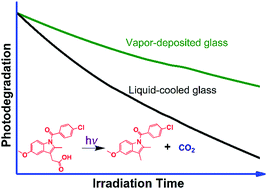Vapor-deposited organic glasses exhibit enhanced stability against photodegradation
Abstract
Photochemically stable solids are in demand for applications in organic electronics. Previous work has established the importance of the molecular packing environment by demonstrating that different crystal polymorphs of the same compound react at different rates when illuminated. Here we show, for the first time, that different amorphous packing arrangements of the same compound photodegrade at different rates. For these experiments, we utilize the ability of physical vapor deposition to prepare glasses with an unprecedented range of densities and kinetic stabilities. Indomethacin, a pharmaceutical molecule that can undergo photodecarboxylation when irradiated by UV light, is studied as a model system. Photodegradation is assessed through light-induced changes in the mass of glassy thin films due to the loss of CO2, as measured by a quartz crystal microbalance (QCM). Glasses prepared by physical vapor deposition degraded more slowly under UV illumination than did the liquid-cooled glass, with the difference as large as a factor of 2. Resistance to photodegradation correlated with glass density, with the vapor-deposited glasses being up to 1.3% more dense than the liquid-cooled glass. High density glasses apparently limit the local structural changes required for photodegradation.



 Please wait while we load your content...
Please wait while we load your content...
